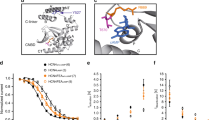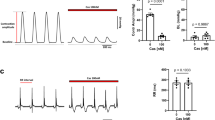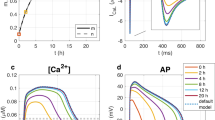Abstract
THE influx of Ca2+ due to the transmembrane calcium current, ICa, has a fundamental role in cardiac pacemaker activity, in the action potential plateau and in excitation-contraction coupling. Both sympathetic and parasympathetic neurotransmitters can modulate ICa (ref. 1). Recent studies indicate that in both the cardiovascular2-7 and the central nervous systems8,9, nerve varicosities exist that contain a novel non-adrenergic, non-cholinergic peptide—calcitonin gene-related peptide (CGRP)10. Although CGRP is known to exert strong positive inotropic3-5,7,11 and chronotropic3,11 effects, as well as to cause vasodilatation2,6,12,13, very little is known about the ionic mechanisms of these effects14,15. Here we report that CGRP dramatically increases ICa in single heart cells. Although this CGRP-induced increase in ICa resembles the effect of β-adrenergic agonists, our results demonstrate some significant differences between the effects of CGRP and these agonists: (1) the increase due to CGRP cannot be blocked by β-adrenergic antagonists; (2) the CGRP-induced effect is transient; and, (3) CGRP can inhibit isoproterenol-stimulated ICa. Our results provide the first electrophysiological evidence that CGRP can significantly modulate ICa in the heart, and suggest a new additional mechanism for the neurogenic control of cardiac function.
This is a preview of subscription content, access via your institution
Access options
Subscribe to this journal
Receive 51 print issues and online access
$199.00 per year
only $3.90 per issue
Buy this article
- Purchase on Springer Link
- Instant access to full article PDF
Prices may be subject to local taxes which are calculated during checkout
Similar content being viewed by others
References
Reuter, H. A. Rev. Physiol. 41, 413–424 (1979).
Shoji, T., Ishihara, H., Ishikawa, T., Saito, A. & Goto, K. Naunyn-Schmiedebergs Archs Pharmak. 336, 438–444 (1987).
Miyauchi, T., Ishikawa, T., Sugishita, Y., Saito, A. & Goto, K. J. cardiovasc. Pharmacol. 10, 675–682 (1987).
Saito, A., Ishikawa, T., Kimura, S. & Goto, K. J. Pharma. exp. Ther. 243, 731–736 (1987).
Ishikawa, T., Okamura, N., Saito, A., Masaki, T. & Goto, K. Circulation Res. 63, 726–734 (1988).
Kawasaki, H., Takasaki, K., Saito, A. & Goto, K. Nature 335, 164–167 (1988).
Saito, A., Kimura, S. & Goto, K. Am. J. Physiol. 250, H693–H698 (1986).
Rosenfeld, M. G. et al. Nature 304, 129–135 (1983).
Mason, R. T. et al. Nature 308, 653–655 (1984).
Amara, S. G., Jonas, V., Rosenfeld, M. G., Ong, E. S. & Evans, R. M. Nature 298, 240–244 (1982).
Franco-Cereceda, A. & Lundberg, J. M. Naunyn-Schmiedebergs Archs Pharmak, 337, 649–655 (1988).
Brain, S. D., Williams, T. J., Tippins, J. R., Morris, H. R. & MacIntire, I. Nature 313, 54–56 (1985).
Edvinsson, L., Fredholm, B. B., Hamel, E. & Jansen, I. Neurosci. Lett. 58, 213–217 (1985).
Satoh, M. et al. Peptides 7, 631–635 (1986).
Marshall, I. & Craig, R. K. in Vasodilatation, 81–87 (ed. Vanhoutte, P. M.) (Raven, New York 1988).
Kameyama, M., Hofmann, F. & Trautwein, W. Pflügers Arch. ges. Physiol. 405, 285–293 (1985).
Goltzman, D. & Mitchell, J. Science 227, 1343–1345 (1985).
Sigrist, S. et al. Endocrinology 119, 381–389 (1986).
Maton, P. N. et al. Am. J. Physiol. 254, G789–G794 (1988).
Giles, W., Nakajima, T., Ono, K. & Shibata, E. F. J. Physiol., Lond. 415, 233–249 (1989).
Ishikawa, T., Okamura, N., Saito, A. & Goto, K. J. mol. cell. Cardiol. 19, 723–727 (1987).
Fisher, R. A., Robertson, S. M. & Olson, M. S. Endocrinology 123, 106–112 (1988).
Ohhashi, T. & Jacobowitz, D. M. Peptides 9, 613–617 (1988).
Giles, W., van Ginneken, A. & Shibata, E. F. in Cardiac Muscle: The Regulation of Excitation and Contraction, 1–27 (ed. Nathan, R. D) (Academic, Orlando 1986).
Franco-Cereceda, A., Saria, A. & Lundberg, J. M. Acta Physiol. scand. 131, 319–320 (1987).
Hamill, O. P., Marty, A., Neher, E., Sakmann, B. & Sigworth, F. J. Pflügers. Arch. ges Physiol. 391, 85–100 (1981).
Author information
Authors and Affiliations
Rights and permissions
About this article
Cite this article
Ono, K., Delay, M., Nakajima, T. et al. Calcitonin gene-related peptide regulates calcium current in heart muscle. Nature 340, 721–724 (1989). https://doi.org/10.1038/340721a0
Received:
Accepted:
Issue Date:
DOI: https://doi.org/10.1038/340721a0
This article is cited by
-
ARNIs: balancing “the good and the bad” of neuroendocrine response to HF
Clinical Research in Cardiology (2020)
-
Cardiac Pacemaker Cells Generate Cardiomyocytes from Fibroblasts in Long-Term Cultures
Scientific Reports (2019)
-
Endothelin-A receptor mediates cardiac inhibition by regulating calcium and potassium currents
Nature (1994)
-
Calcitonin-gene-related peptide activates the muscarinic-gated K+ current in atrial cells
Pfl�gers Archiv European Journal of Physiology (1991)
-
Effects of calcitonin gene-related peptide on membrane currents in mammalian cardiac myocytes
Pfl�gers Archiv European Journal of Physiology (1991)
Comments
By submitting a comment you agree to abide by our Terms and Community Guidelines. If you find something abusive or that does not comply with our terms or guidelines please flag it as inappropriate.



